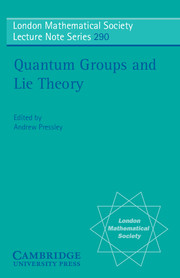Book contents
- Frontmatter
- Contents
- Introduction
- Lectures on Cyclotomic Hecke Algebras
- An Introduction to Group Doublecross Products and Some Uses
- Canonical Bases and Piecewise-linear Combinatorics
- Integrable and Weyl Modules for Quantum Affine sl2
- Notes on Balanced Categories and Hopf Algebras
- Lectures on the dynamical Yang-Baxter Equations
- Quantized Primitive Ideal Spaces as Quotients of Affine Algebraic Varietie
- Representations of Semisimple Lie Algebras in Positive Characteristic and Quantum Groups at Roots of Unity
- The Yang-Baxter Equation for Operators on Function Fields
- Noncommutative Differential Geometry and Twisting of Quantum Groups
- Finite Quantum Groups and Pointed Hopf Algebras
- On Some Two Parameter Quantum and Jordanian Deformations, and their Coloured Extensions
- Tensor Categories and Braid Representations
Lectures on the dynamical Yang-Baxter Equations
Published online by Cambridge University Press: 05 November 2009
- Frontmatter
- Contents
- Introduction
- Lectures on Cyclotomic Hecke Algebras
- An Introduction to Group Doublecross Products and Some Uses
- Canonical Bases and Piecewise-linear Combinatorics
- Integrable and Weyl Modules for Quantum Affine sl2
- Notes on Balanced Categories and Hopf Algebras
- Lectures on the dynamical Yang-Baxter Equations
- Quantized Primitive Ideal Spaces as Quotients of Affine Algebraic Varietie
- Representations of Semisimple Lie Algebras in Positive Characteristic and Quantum Groups at Roots of Unity
- The Yang-Baxter Equation for Operators on Function Fields
- Noncommutative Differential Geometry and Twisting of Quantum Groups
- Finite Quantum Groups and Pointed Hopf Algebras
- On Some Two Parameter Quantum and Jordanian Deformations, and their Coloured Extensions
- Tensor Categories and Braid Representations
Summary
Introduction
This paper arose from a minicourse given by the first author at MIT in the Spring of 1999, when the second author extended and improved his lecture notes of this minicourse. It contains a systematic and elementary introduction to a new area of the theory of quantum groups – the theory of the classical and quantum dynamical Yang-Baxter equations.
The quantum dynamical Yang-Baxter equation is a generalization of the ordinary quantum Yang-Baxter equation. It first appeared in physical literature in the work of Gervais and Neveu [GN], and was first considered from a mathematical viewpoint by Felder [F], who attached to every solution of this equation a quantum group, and an interesting system of difference equations, – the quantum Knizhnik-Zamolodchikov-Bernard (qKZB) equation. Felder also considered the classical analogue of the quantum dynamical Yang-Baxter equation – the classical dynamical Yang-Baxter equation. Since then, this theory was systematically developed in many papers, some of which are listed below. By now, the theory of the classical and quantum dynamical Yang-Baxter equations and their solutions has many applications, in particular to integrable systems and representation theory. To discuss this theory and some of its applications is the goal of this paper.
The structure of the paper is as follows.
In Section 2 we consider the exchange construction, which is a natural construction in classical representation theory that leads one to discover the quantum dynamical Yang-Baxter equation and interesting solutions of this equation (dynamical R-matrices).
- Type
- Chapter
- Information
- Quantum Groups and Lie Theory , pp. 89 - 129Publisher: Cambridge University PressPrint publication year: 2002
- 12
- Cited by



